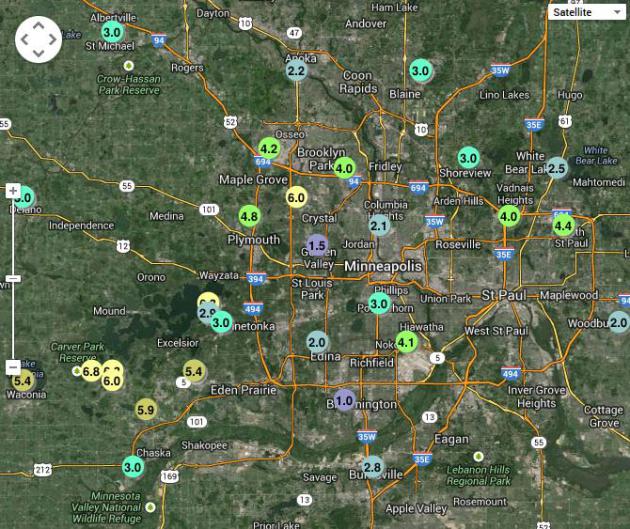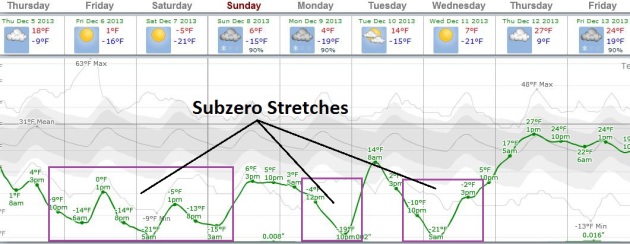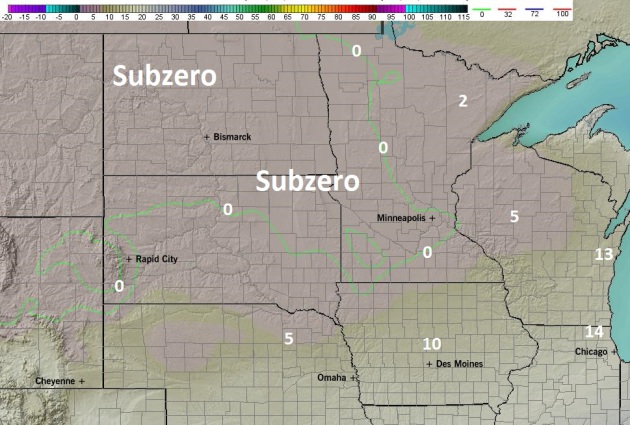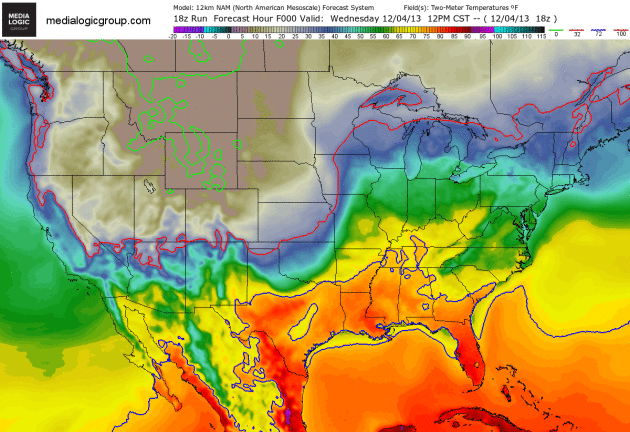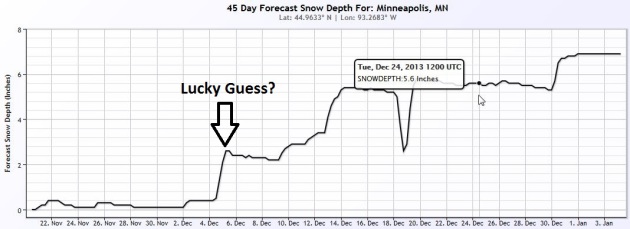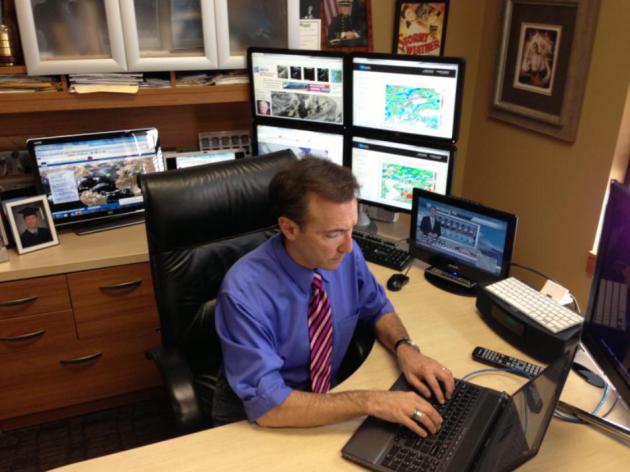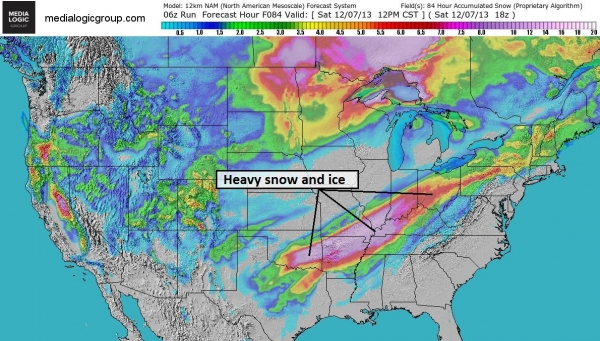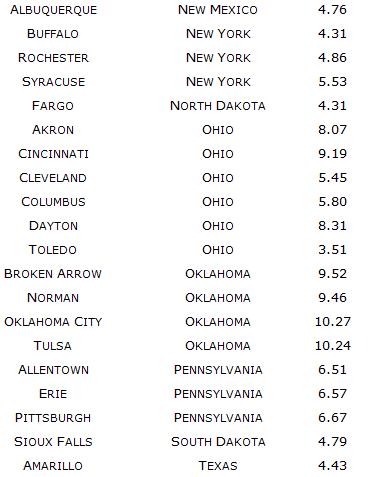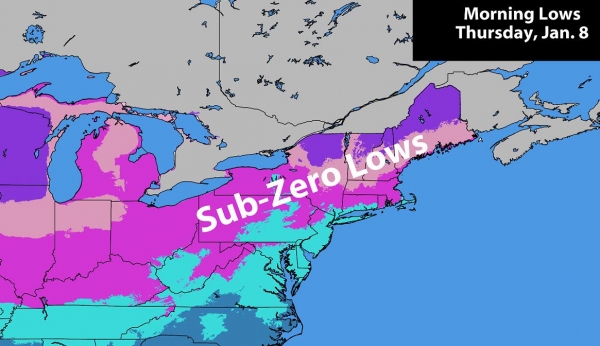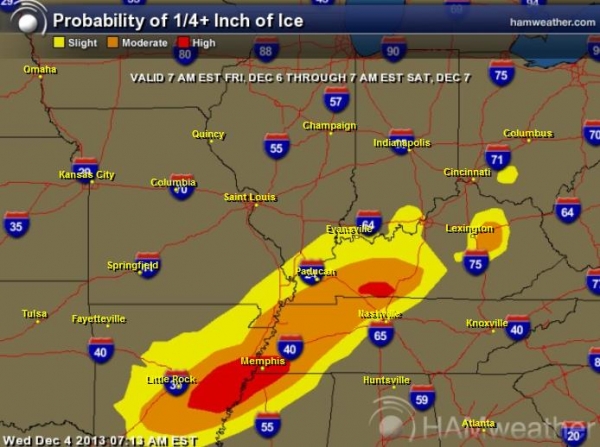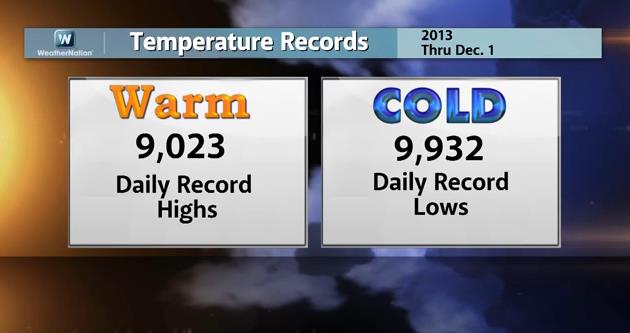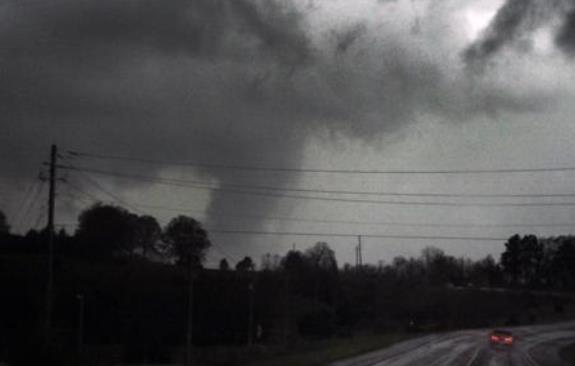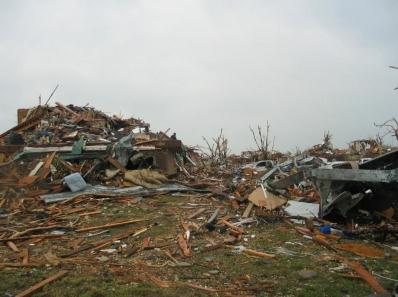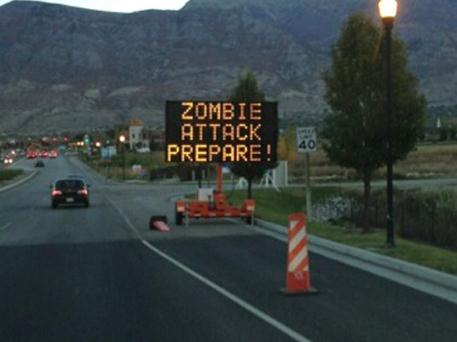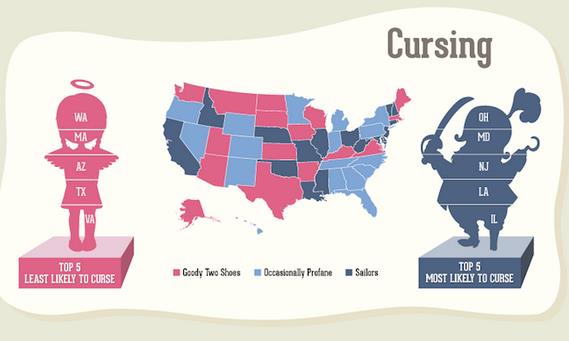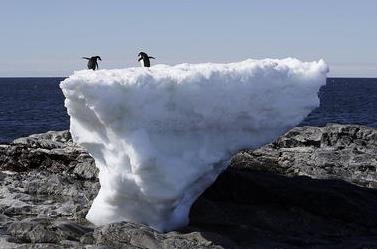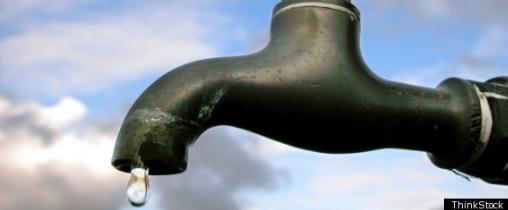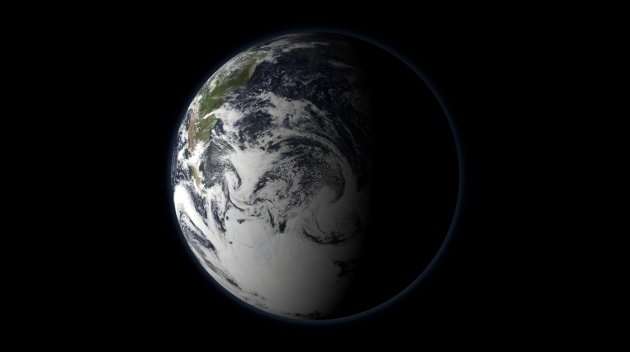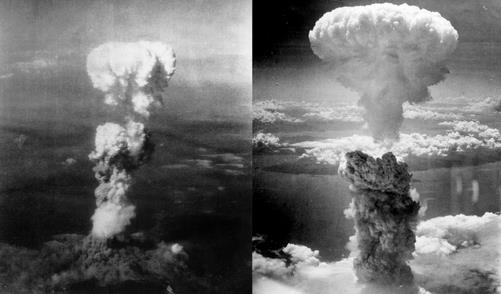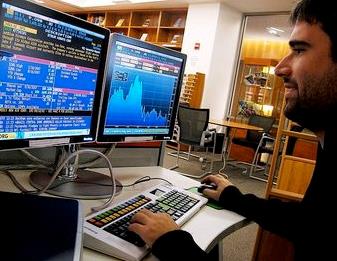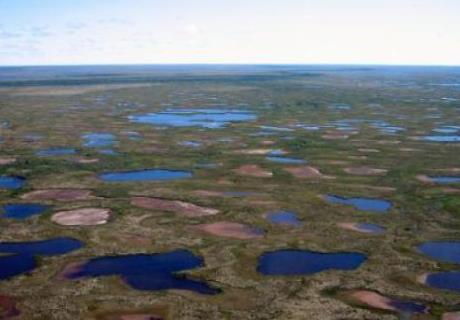Less "Riff Raff"
I
vividly remember my first Minnesota winter, 30 years ago, a record 98.6
inches of snow submerging the Twin Cities, waist-deep in snow, thinking
"what have I done?" A friend at KARE-11 (WTCN) took me aside. "Paul, at
least the cold and snow keeps the riff raff out" he whispered. Really?
Then how did I get in? His other exhortation: the crime rate drops - and
your garbage doesn't stink.
So much to look forward to.
One
of the coldest blobs of Yukon chill in a decade is about to drain out of
the frozen wastelands of western Canada. By Friday daytime "highs"
struggle to top 0F; temperatures may hold below zero Saturday in spite
of a bright, pleading sun.
This will be one of the coldest outbreaks of the winter - and no, it doesn't necessarily mean the entire winter will be Nanook.
If
you're dressed properly & active you can reduce the risk of
frostbite. The "no-exposed-skin" rule comes into play for kids at the
bus stop, with a wind chill of -10F today, dipping to -20F Friday AM.
We may be brushed by light snow Sunday night, but highs reach the 20s late next week; a few 30s the 3rd week of December.
This too shall pass, but short term? Cash in those frequent flier miles. Or just grin and bear it.
* photo above: Clint Austin, Duluth News Tribune.
Extra-Fickle Snowfall Pattern. The metro-scale snowfall total map (courtesy of the
Twin Cities NWS)
had me scratching my head: 1" at Bloomington, 2" at Edina and North
Minneapolis, 1.5" Golden Valley, but 6" north of Crystal? Plowable -
just enough snow to foul up traffic and get snow lovers excited.
Coldest In 4 Years?
This will probably be the coldest spell in at least 4 years, possibly a
decade for parts of Minnesota. Historically winter temperatures bottom
out in mid-January, so this is coming a good 5 weeks ahead of schedule,
which is unusual, but not unprecedented. Twin Cities temperatures may
hold below zero much of Friday and Saturday, more subzero weather Monday
night, again Tuesday PM into Wednesday morning. 20s (above!) return by
the end of next week, according to the ECMWF model. Source:
weatherspark.
Probability Of Subzero Windchills: December 12-18.
Here's a new NOAA product showing the risk of wind chills dipping below
0F: 90% for the Red River Valley, with a high probability extending
into New England.
Midday Saturday Temperatures.
The map above shows NOAA's NAM surface temperature guidance, valid at
noon Saturday, readings just below zero in the Twin Cities metro, along
with most of central and western Minnesota and the Dakotas. At least the
sun will be out. Source: Ham Weather.
Canadian Invasion.
Here is the 12km NAM model showing predicted temperatures into Saturday
night; the green solid line is the 0F isotherm, pushing as far south as
Chicago and Kansas City by late week. How quickly can you get to
Florida? Loop: NOAA and Ham Weather.
NOAA Climate Forecast System.
Here is the latest CFS model, showing two episodes of bitter weather
for the Twin Cities and Upper Midwest, from today into the middle of
next week, another numbing spell predicted around Christmas.
Temperatures bounce back to near freezing for much of the first half of
January. In theory. Source: NOAA and Ham Weather.
Skill - Or Luck?
Here is the NOAA CFS 45 day (!) snow cover trend I showed you back on
November 21. I was (and still am) highly skeptical that there's a shred
of skill going out that far, but the model did a pretty good job picking
up yesterday's snow event, forecasting 2-3" for the metro - on the low
side but the timing of the snowy spike raised a few eyebrows. For the
record, CFS predicts 5-6" snow on the ground in time for Santa's
triumphant arrival December 24.
Alerts Broadcaster Briefing: Issued Wednesday, December 4, 2013.
*
Push of arctic air sparks a period of ice and singificant snow from the
Texas Panhandle into Oklahoma, Arkansas, the Middle Mississippi Valley
into the Ohio Valley late Thursday into Saturday morning.
*
Potential for 1/4" glaze ice amounts from near Little Rock to Memphis
and Bowling Green Thursday night into early Saturday - capable of
significant travel challenges and downed trees, powerlines. Power
outages are possible as this storm ripples across the Mid South into the
Ohio Valley.
* No major snow/ice problems for major east coast
cities into Saturday. A cold rain is likely New York to D.C. Friday into
Saturday.
A Stripe of Snow & Ice.
Our in-house Alerts Broadcaster models show the greatest potential for
plowable snows and ice Thursday into Saturday from Oklahoma City into
northern Arkansas and the Mid South, with significant snow into Ohio,
western Pennsylvania and upstate New York.
Snowfall Potential.
Here are a few select city amounts, the latest snowfall predictions,
showing the most concern from the Texas Panhandle into western Kentucky
and Ohio. Friday may be the most problematic day for travel (land and
air).
Thursday Ice Risk.
The red-shaded area shows a high risk of .25" of glaze ice or more,
capable of disrupting travel and triggering power outages - the greatest
concern over southeast Oklahoma and western/northwestern Arkansas.
Friday Ice Potential.
By Friday surface temperatures dip below 32F in the Memphis area,
possibly Nashville, creating freezing rain (glaze ice) problems.
Moderate to heavy snow is likely just north and west of the regions of
heaviest ice, brushing Louisville, Cincinnati and Columbus.
Summary:
One of the coldest outbreaks in a decade will push into the USA later
this week, preceded by a band of snow and ice pushing unusually far
south. Facilities and staff from Little Rock and Hot Springs to Memphis,
Nashville, Louisville and Columbus should monitor forecasts - watches
and warnings are inevitable, and the risk of winter-related impacts to
operations will be high late Thursday into Saturday morning.
Paul Douglas - Senior Meteorologist - Alerts Broadcaster
Bitter Outbreaks In A Warming World.
How on Earth can we get arctic "invasions" if the atmosphere is
warming? It's a good question. Nature rarely moves in a perfectly
straight line, and that certainly applies to the atmosphere. As one
climate scientist told me recently "if we ever get to the point where we
don't see cold fronts or snow we'll be too far gone to do anything
about climate change." The reality: in spite of a warmer atmosphere
(globally) and rapidly warming oceans, bitter air will still find its
way into the USA when prevailing jet stream wind patterns are favorable.
As they will be over the next week or so. We focus on the coming cold
wave and cold vs. warm weather records for the USA in today's edition of
Climate Matters: "
WeatherNation
Chief Meteorologist Paul Douglas looks at the coming cold snap for the
United States and shows the bigger picture of the overall warming
trends. This is the first time in 20 years that there were more cold
weather records than warm weather records, and how does it play into the
overall climate picture?"
2013 On Track To Be 7th Warmest Year Since 1850.
Although the USA will wind up with more record lows than highs for
2013, worldwide it was another unusually warm year for air and ocean
temperatures. Here's an excerpt from
Climate Central: "
The
world is on track to have its 7th warmest year on record in 2013, which
is up from 2012, which was the globe’s 9th warmest year, according to a
new report released on Wednesday. The report from the World Meteorological Organization
in Geneva found that the January to September period tied with 2003 for
the 7th warmest such period on record, with an average global surface
temperature that was 0.86°F above the 1961-1990 average. In addition,
global average sea level reached a record high this year, with an
average rate of increase of 0.13 inches per year, which is double the
observed 20th century rate. Sea level is rising because of melting polar
ice caps and warming ocean temperatures that cause the water to expand
over time..."
Graphic credit above: "
Global average surface temperature departures from average from different global datasets." Credit: WMO.
National Standards Urged For U.S. Tornado Protection.
Better warning detection and warning systems only go so far. If no
basement or underground shelter (or "safe room") is available and an
EF4+ tornado is approaching, the odds of survival are small. Lives can
be saved by enacting stronger building codes, but that will ultimately
result in more expensive construction techniques, costs that will
inevitably be passed on to consumers. Here's a clip from
Reuters: "
National standards should be set for building construction,
storm shelters and emergency communications to reduce death and damage
from tornados, a federal agency that studied the deadly 2011 tornado in
Joplin, Missouri, recommended on Thursday.
The National Institute of Standards and Technology said 135 of the 161
deaths from the May 22, 2011 tornado resulted from building failure. The
EF-5 tornado was the deadliest single tornado in the United States
since official records were first kept in 1950, the agency said..."
Photo credit above: "A funnel cloud is spotted moving east over Highway 5 near Rosebud, Arkansas April 10, 2013." Credit: Reuters/Gene Blevins.
Federal Agency Releases Joplin Tornado Study.
No building will ever be tornado-proof, but how can we strengthen
national building codes to make commercial and residential buildings
more tornado-resistant? Here's a clip from
The Washington Post: "...
The
overarching conclusion of our two-year study is that death and
destruction from tornadoes can be reduced,” said Eric Letvin, the
institute’s director of disaster and failure studies. “Our scientific
understanding of tornadoes and their effects has matured substantially,”
he added. “It’s time to begin developing and implementing nationally
accepted standards and codes that directly address tornado hazards.” The
May 2011 Joplin tornado killed 161 people and destroyed thousands of
buildings, including homes, churches, businesses big and small, and one
of the city’s two hospitals. The study found that all but 26 of the
deaths came from building collapses..." (Images above: NOAA).
America's Southern States, From Sunbelt To Stormbelt. Here's a clip from a photo essay at
The Guardian: "
When
Robert Leslie first visited the US as a child in the late 1960s, it was
the world's most productive country, driven by the sunbelt stretching
across the south from Florida to California. Stormbelt
is a collection of photographs taken between 2009 and 2012, when Leslie
returned to the region. What he found was an area battling not just the
economic recession, but also natural disasters such as hurricanes,
forest fires and drought. Caption text by Edward Burtynsky."
In A Tornado, What Would You Run To Save?
The most likely answer: the things that can't be replaced: photo
albums, family heirlooms, your children (!) - the list goes on. This is
one (of many) good reasons to back up your photos in the cloud, just in
case. Here's an excerpt of a press release at
Digital Journal that got me thinking (it hurt my brain so I stopped): "
We've
all asked ourselves the question: Should we ever be confronted with a
natural disaster - a tornado, a hurricane, a flood - what is the one
thing we'd go for that would give us solace, were we to lose everything?
Most often, the answer would be: The photographs. It's a universal
sentiment that has found its way into "Running for Photographs," a
heartrending music video featuring family photos and keepsakes that were
scattered hundreds of miles across the states and discovered in the
aftermath of the recent tornadoes that pounded the Midwest. Dedicated to
storm victims everywhere and to all those who help, the music video is
posted on YouTube at http://youtu.be/71XBxHCk-kE..."
Planet Money Makes A T-Shirt. If you haven't checked out the 5 chapters in this multimedia
NPR production, it's definitely worth a look. It will make you think twice about what goes into your next shirt.
Music Lessons Boost Emotional, Intellectual Development. Yes, try to get your kids or grandkids to play an instrument - any instrument will due! Here's a clip from
Pacific Standard Magazine: "
There is no longer any doubt that student musicians perform better than their peers on a variety of measures, including getting better grades. But the chicken-and-egg question
lingers: Is this effect due to their musical training? Or are sharper,
more motivated kids more likely to take up an instrument? While it
doesn’t provide a definitive answer, new research from Germany presents evidence that improved academic performance truly is a result of musical training..."
How (Hypothetical) Zombie Infections Might Mimic A Major Influenza Outbreak.
Medium.com has the vaguely terrifying story; here's an excerpt: "
When
it comes to the zombie movies, it’s easy to imagine that the way the
living dead spread through the population has little or nothing to do
with real infectious diseases. Not so! Today, Caitlyn Witkowski at
Bryant University in Smithfield and Brian Blais at Brown University in
Providence, both in Rhode Island, show how the way people turn into
zombies in horror flicks, is remarkably similar to real epidemics. In
fact, the links are so similar that it is possible to use the same
mathematical models to describe both types of epidemic..."
The "Sweariest" States In The USA? Wait, Wisconsin is one of the least courteous states in the USA? Really? Here's an excerpt from a story at
The Atlantic: "...
A
new map, though, takes a more complicated approach. Instead of using
text, it uses data gathered from ... phone calls. You know how, when you
call a customer service rep for your ISP or your bank or what have you,
you're informed that your call will be recorded? Marchex Institute, the data and research arm of the ad firm Marchex, got ahold of the data that resulted from some recordings,
examining more than 600,000 phone calls from the past 12 months—calls
placed by consumers to businesses across 30 different industries. It
then used call mining technology to isolate the curses therein,
cross-referencing them against the state the calls were placed from..."
Map credit: Marchex.
Ron Burgundy Interviews Payton Manning For SportsCenter. If you haven't seen this it's worth a look, courtesy of
Athlete Swag.
Climate Stories....
When Global Warming Kicks Into Overdrive How Will We Know?
What many scientists are calling the biggest environmental threat we've
ever faced as a species may require a new network of sensors trained on
potential tipping points. Here's an excerpt from
The Christian Science Monitor: "...
The
panel, convened by the National Research Council, recommends the
establishment of an early-warning system for abrupt change, noting that
even slow warming trends can reach levels that threaten to drive plant
and animal species extinct, disrupt agriculture, and trigger political
instability in the space of a few years to a few decades – well within
the span of a human lifetime. Such a monitoring system, whose specific
definition the panel acknowledges it has left to others, is crucial to
help decisionmakers anticipate abrupt changes as much as possible and
begin to adapt ahead of time..."
Photo credit above: "Two
Adelie penguins stand atop a block of melting ice on a rocky shoreline
at Cape Denison, Commonwealth Bay, in East Antarctica, in 2010." Pauline Askin/Reuters/File
Climate Change Is Happening. Will L.A. Have Enough Water? The short answer appears to be no.
KCET has the story; here's an excerpt: "...
More
than just disappearing polar ice caps, climate change has far-reaching
consequences, such as increased rates of allergies, diseases, and even death,
as Los Angeles writer Linda Marsa explains in her new book, "Fevered:
Why a Hotter Planet Will Hurt Our Health -- and how we can save
ourselves." It also means there will be water shortages in Los Angeles,
unless we become more efficient with our supply. Right now only 11
percent of the Los Angeles's water comes from local sources, and 1 percent is recycled.
Fifty two percent comes from the Colorado River through the
Metropolitan Water District. Thirty six percent comes from the Eastern
Sierra Nevadas through the Los Angeles Aqueduct. Unfortunately, the
Colorado River is currently the country's most endangered river from being so overused, and all but one of the Sierra's 24 major watersheds are impaired..." (Image: ThinkStock).
Panel Says Global Warming Carries Risk Of Deep Changes. It's the unknown unknowns that keep scientists up at night. Here's an excerpt from a Justin Gillis article at
The New York Times: "...
It cited the outbreak of mountain pine beetles
in the American West and in Canada. The disappearance of bitterly cold
winter nights that used to kill off the beetles has allowed them to
ravage tens of millions of acres of forests, damage so severe it can be
seen from space. Likewise, a drastic decline of summer sea ice
in the Arctic has occurred much faster than scientists expected. The
panel warned that Arctic sea ice could disappear in the summer within
several decades, with severe impacts on wildlife and human communities
in the region, and unknown effects on the world’s weather patterns.
Among the greatest risks in coming years, the panel said, is that
climate change could greatly increase the extinction rate of plants and
animals, essentially provoking the sixth mass extinction in the earth’s
history..."
The Climate Bomb Redux.
It's hard to wrap your head around how much additional heat energy
Earth's atmosphere and oceans are retaining due to a sharp spike in
greenhouse gases. This story at
Discover Magazine tries to provide some perspective; here's an excerpt: "
Imagine
four atomic bombs like the one that incinerated Hiroshima, Japan on
Aug. 6, 1945 exploding in the atmosphere every single second of every
day of every week and every month, year after year, ad infinitum. That,
says John Cook and colleagues at the web site Skeptical Science, is a
good way to understand the excess heat that is building up in the
atmosphere as a result of humankind’s emissions of carbon dioxide and
other greenhouse gases. Four atomic bombs’ worth of extra energy, every
second..."
Photo credit above: "
Mushroom clouds
blossom over Hiroshima (left) and Nagasaki (right) from atom bombs
dropped by the United States on August 6 and 9, 1945." (Source: Wikimedia Commons).
Bloomberg LP Launches First Tool That Measures Risk Of "Unburnable Carbon" Assets.
InsideClimate News has the story - here's the introduction: "
In
a move that underscores Wall Street's growing unease over the
business-as-usual strategy of the world's fossil fuel companies, Bloomberg L.P.
unveiled a tool last week that helps investors quantify for the first
time how climate policies and related risks might batter the earnings
and stock prices of individual oil, coal and natural gas companies. The
company's new Carbon Risk Valuation Tool
is available to more than 300,000 high-end traders, analysts and others
who regularly pore over the stream of information that's available
through Bloomberg's financial data and analysis service. The move
significantly broadens and elevates the discussion of "stranded" or
"unburnable" carbon reserves—expanding it beyond climate groups and
sustainability investors to the desks of the world's most active and
influential investors and traders..."
Photo credit above: "
Bloomberg
LP is now offering a Carbon Risk Valuation Tool through its terminal
subscription service (seen here), which is available to more than
300,000 high-end traders, analysts and others." Credit: CUNY Graduate School of Journalism.
Subarctic Lakes Are Drying Up At A Rate Not Seen In 200 Years. Here's a clip from
Science Daily: "...
The
drying of some lakes, which first became visible to the naked eye in
2010, was even more pronounced in summer 2013. "With this type of lake,
precipitation in the form of snow represents 30% to 50% of the annual
water supply," explained the study's lead author, Frédéric Bouchard, a
postdoctoral fellow at Université Laval's Department of Geography and
the Centre for Northern Studies. The kind of desiccation seen by the
researchers is without precedent in 200 years. Isotopic analyses
conducted on the remains of phytoplankton accumulated in lakebed
sediment show that the lakes have maintained water balance for 200
years. This stability was abruptly disrupted a few years ago..."
Photo credit above: "
Desiccated
lakes in Wapusk National Park near Churchill, Manitoba (Canada) are
shown. Desiccation of shallow lakes has occurred recently in response to
lower-than-average snowmelt runoff. This phenomenon appears
unprecedented over the last 200 years." (Credit: Hilary White).

